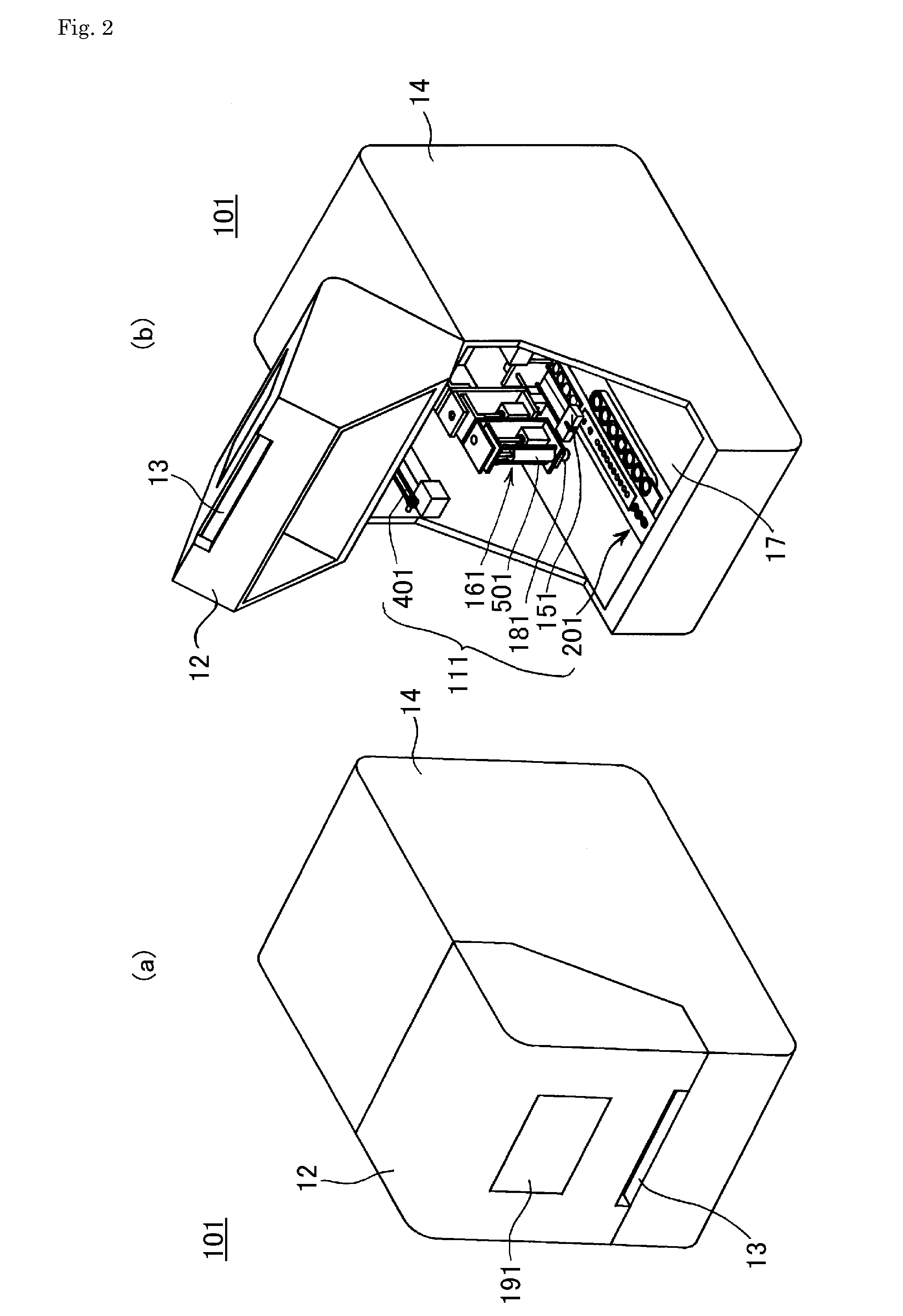Automated nucleic acid processor and automated nucleic acid processing method using multi function dispensing unit
a nucleic acid processing and multi-function technology, applied in the field of automatic nucleic acid processing and automated nucleic acid processing methods using multi-function dispensing units, can solve the problems of inconsistent automation of processing, time-consuming manual opening of the lid by the user, contamination, etc., and achieves high reliability, high precision, and reduced manufacturing costs
- Summary
- Abstract
- Description
- Claims
- Application Information
AI Technical Summary
Benefits of technology
Problems solved by technology
Method used
Image
Examples
first embodiment
[0128]FIG. 2 is a perspective view showing the automated nucleic acid processor using a multi function dispensing unit 101 according to a
[0129]FIG. 2A is a drawing showing an external view of the automated nucleic acid processor 101, which has: an enclosure 14 in which a multi function dispensing unit 111 corresponding to the multi function dispensing unit 11 is built into the interior; a door 12 that covers the aperture of the enclosure 14 such that it can be opened and closed; a control panel 191 corresponding to the control panel 19 having a liquid crystal display portion and operation keys provided on the door 12; and an indentation 13 for opening and closing of the door 12. Here, the size of the enclosure 14 is of the order of approximately 50 cm in depth, approximately 30 cm in width, and approximately 40 cm in height for example.
[0130]FIG. 2B is a drawing showing a state in which the door 12 is open. The interior of the enclosure 14 is provided with the multi function dispens...
second embodiment
[0161]FIG. 9 is a drawing showing an automated nucleic acid processor using a multi function dispensing unit 102 according to a
[0162]The automated nucleic acid processor using a multi function dispensing unit 102 has: a nozzle 182 through which a flow path 182a in which gases are able to pass through the interior, penetrates; as the suction-discharge mechanism 50 that performs the suction and the discharge of gases, a cylinder 502b that is connected with the nozzle 182 and the flow path 182a via a piping 502a and in which a piston is slidable in the interior; a piston rod 502c in which a piston 502d is provided on one end; a heating portion 511 for heating the sealing lid 301 mounted on the nozzle 182; and a measuring part 542 whereby the optical state, including light emissions, colors, color changes, or light variations generated within the amplification solution sealed within the reaction vessel 221, is measurable.
[0163]Dispensing tips 261, tips for separating 262, and tips for p...
fourth embodiment
[0176]FIG. 13 shows an automated nucleic acid processor using a multi function dispensing unit 103 according to a
[0177]FIG. 13A is a drawing showing an external view of the automated nucleic acid processor 103, and is the same as the device 101 according to the first embodiment, although the displayed content and the operation of the control panel 192 are different. Here, elements that are the same as the first embodiment are represented by the same reference symbols, and the descriptions thereof are omitted.
[0178]FIG. 13B is a drawing showing a state in which the door 12 is opened, and a multi function dispensing unit 113 is provided in the interior of the enclosure 14. Furthermore, the multi function dispensing unit 113 has: a nozzle head 163 corresponding to the nozzle head 16, which is provided with one or two or more (one in this example) nozzles 183 corresponding to the nozzles 18, a suction-discharge mechanism 503 corresponding to the suction-discharge mechanism 50, and a mag...
PUM
| Property | Measurement | Unit |
|---|---|---|
| size | aaaaa | aaaaa |
| temperature | aaaaa | aaaaa |
| temperature | aaaaa | aaaaa |
Abstract
Description
Claims
Application Information
 Login to View More
Login to View More - R&D
- Intellectual Property
- Life Sciences
- Materials
- Tech Scout
- Unparalleled Data Quality
- Higher Quality Content
- 60% Fewer Hallucinations
Browse by: Latest US Patents, China's latest patents, Technical Efficacy Thesaurus, Application Domain, Technology Topic, Popular Technical Reports.
© 2025 PatSnap. All rights reserved.Legal|Privacy policy|Modern Slavery Act Transparency Statement|Sitemap|About US| Contact US: help@patsnap.com



